
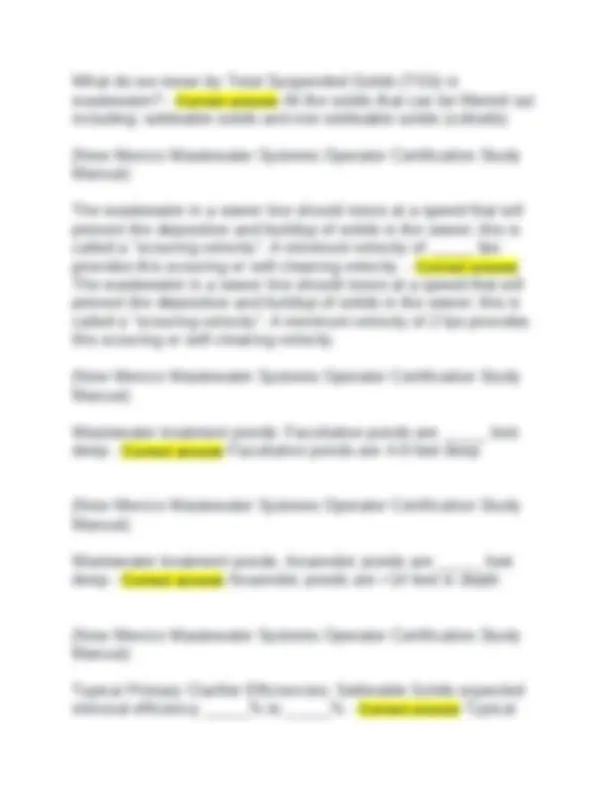
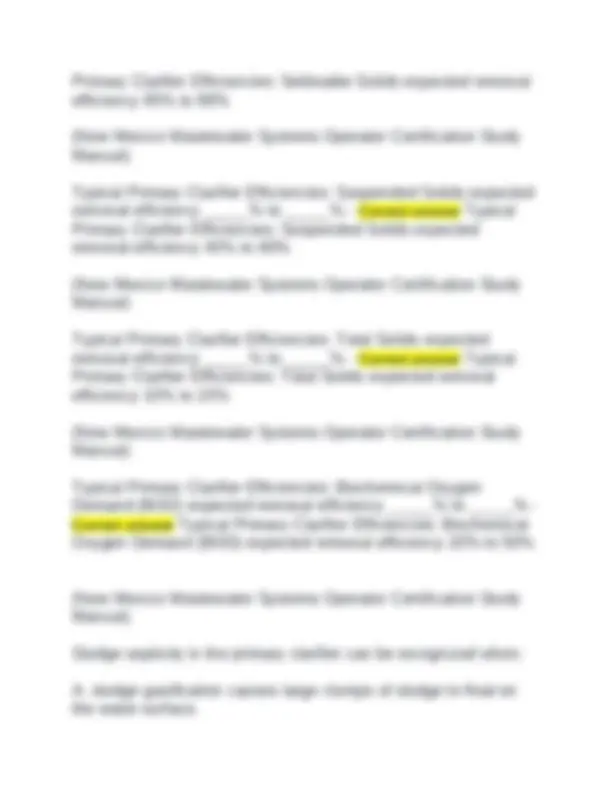
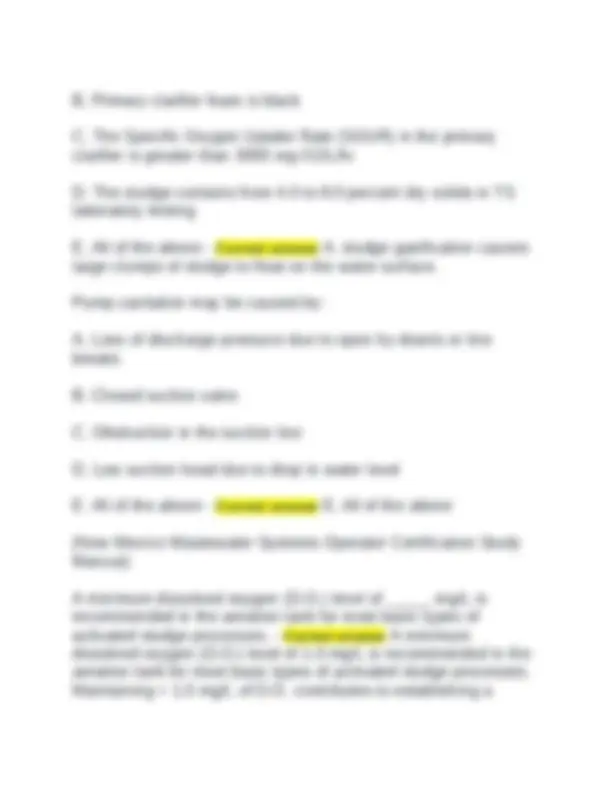
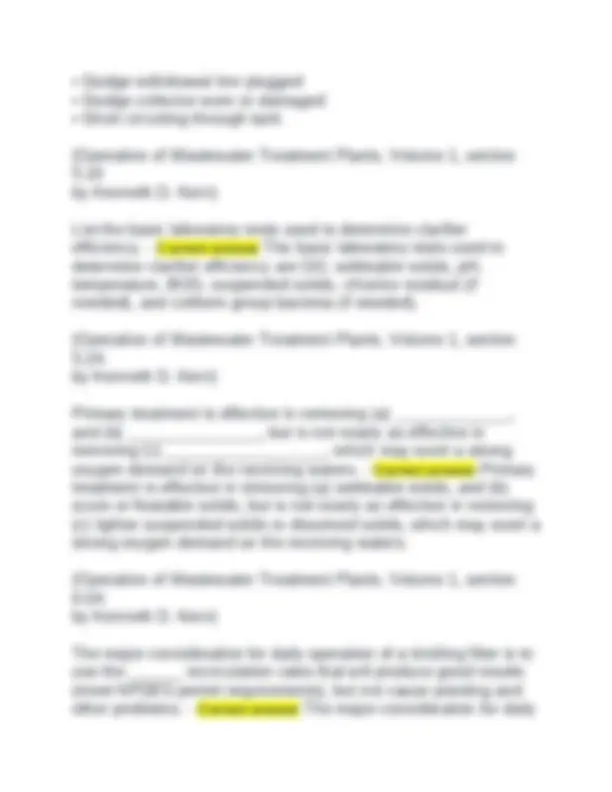
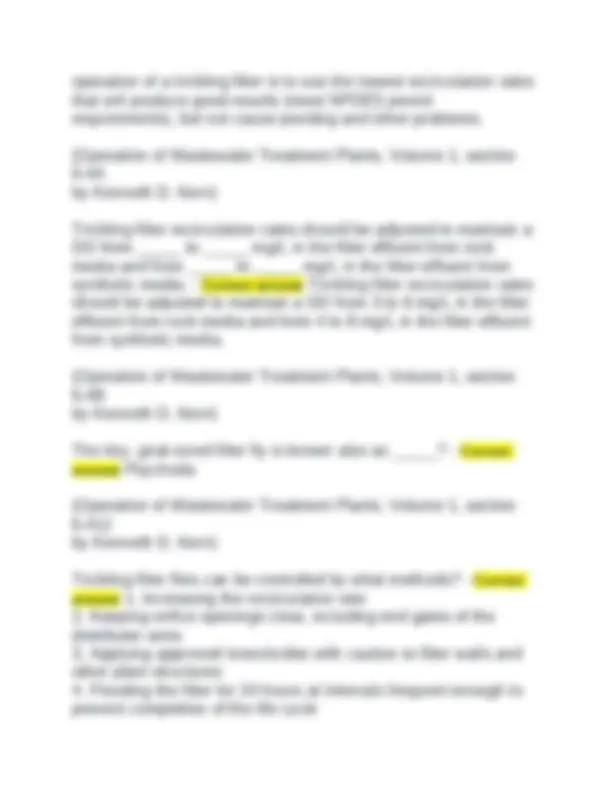
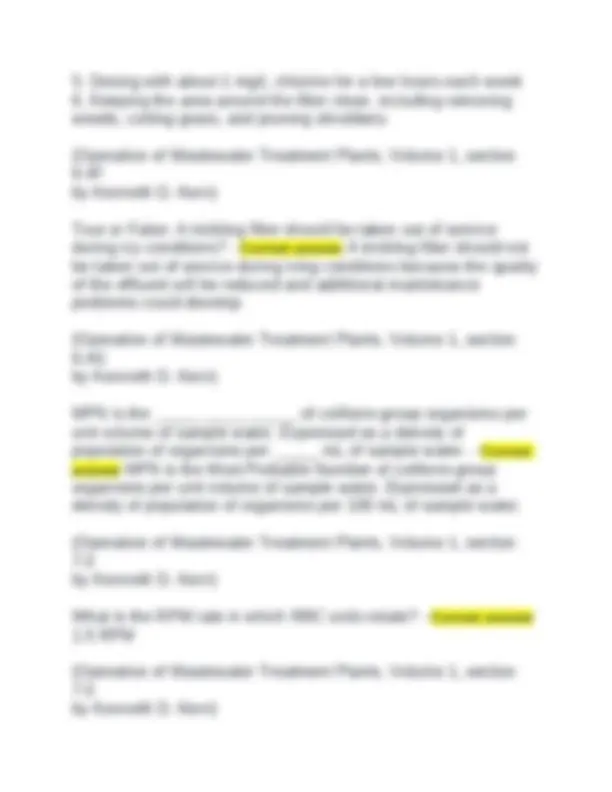
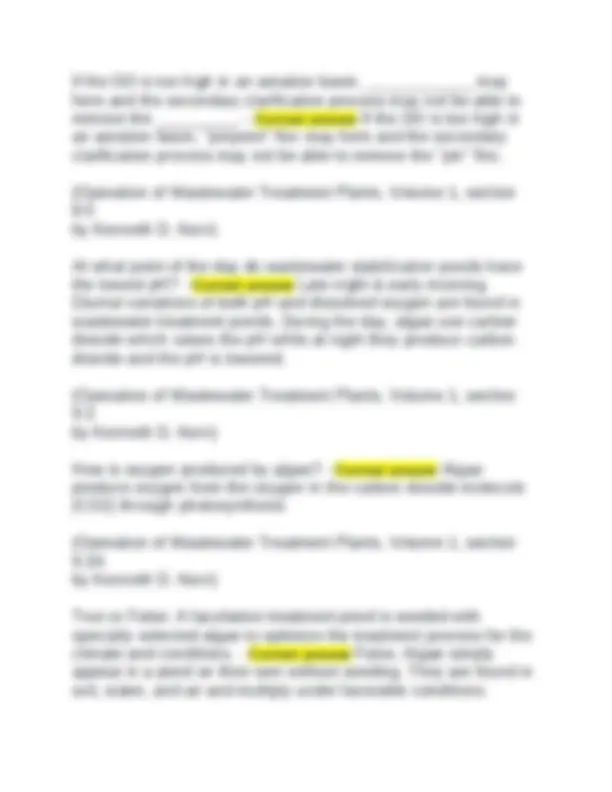
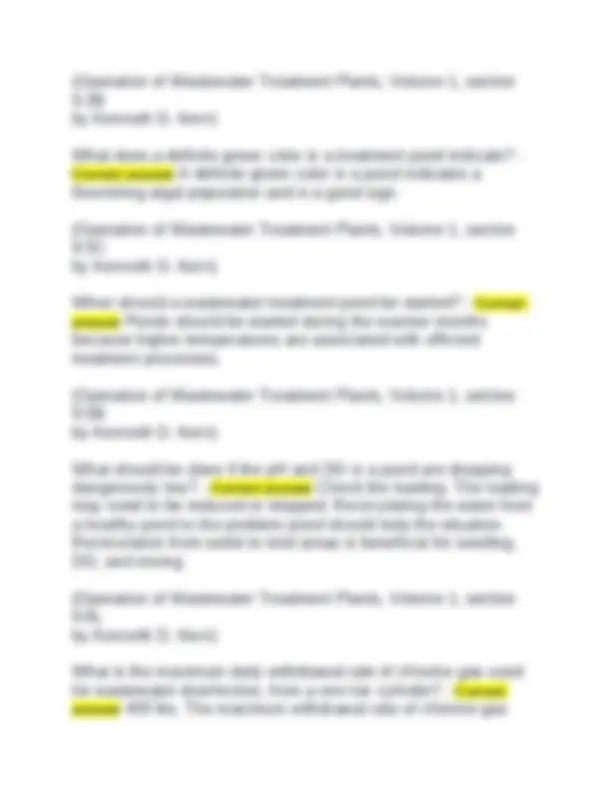
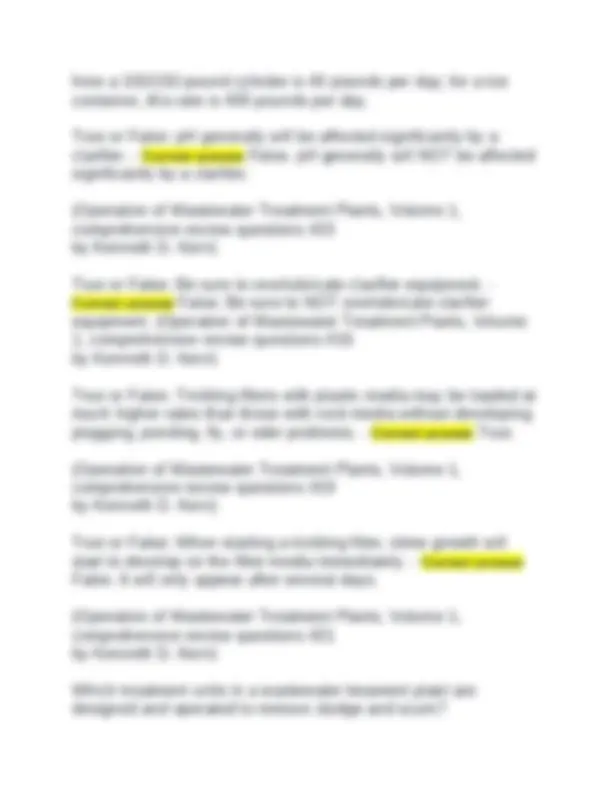
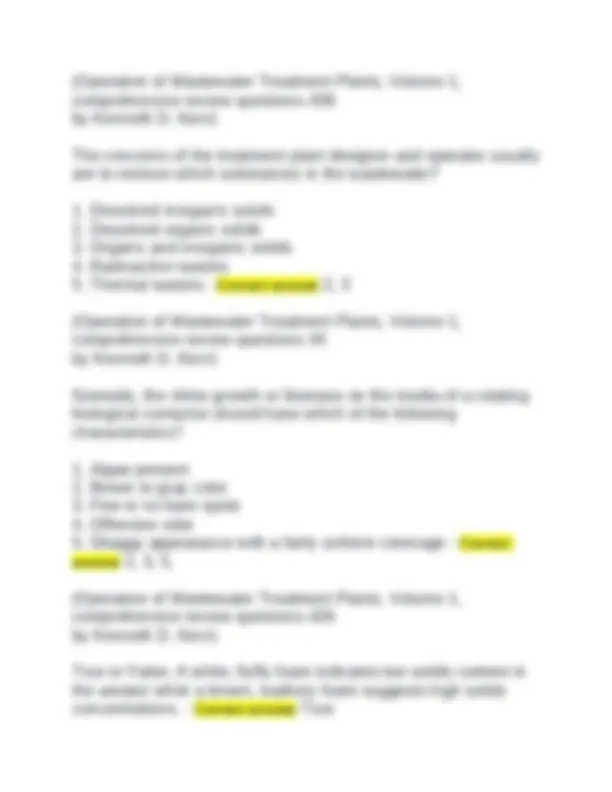
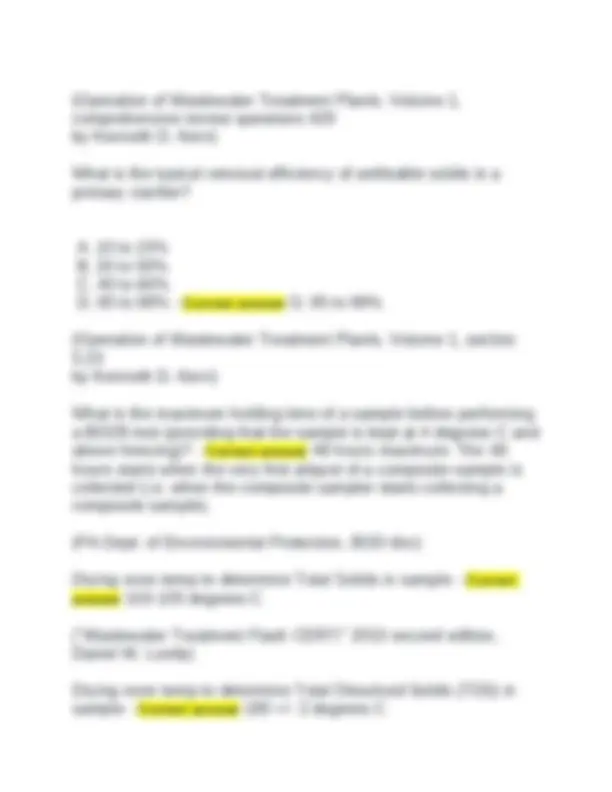
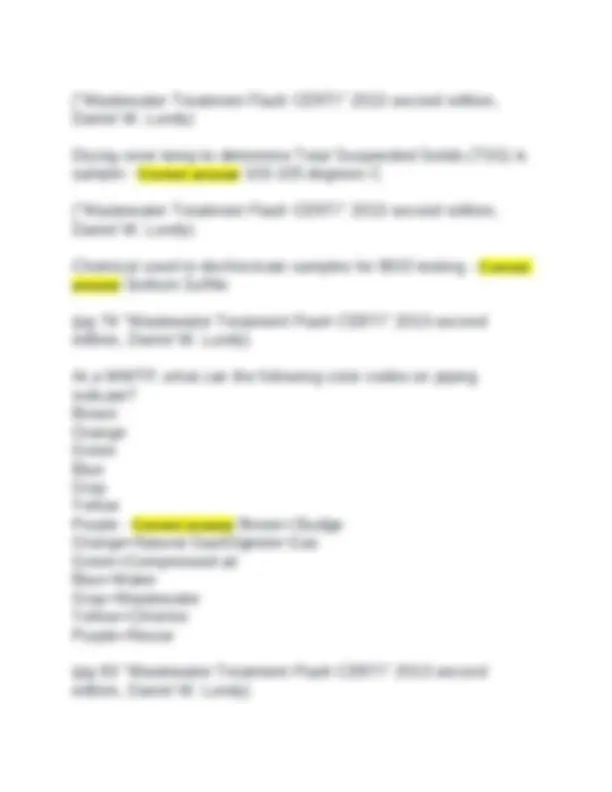
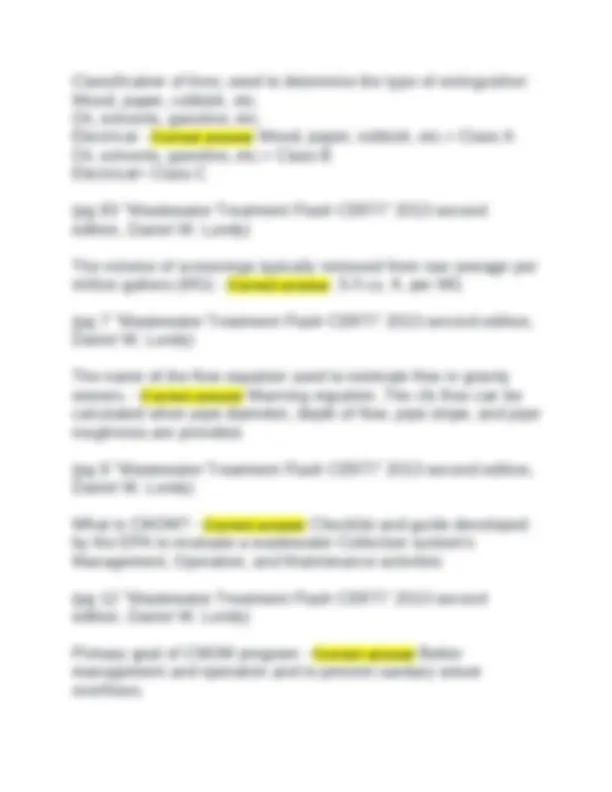
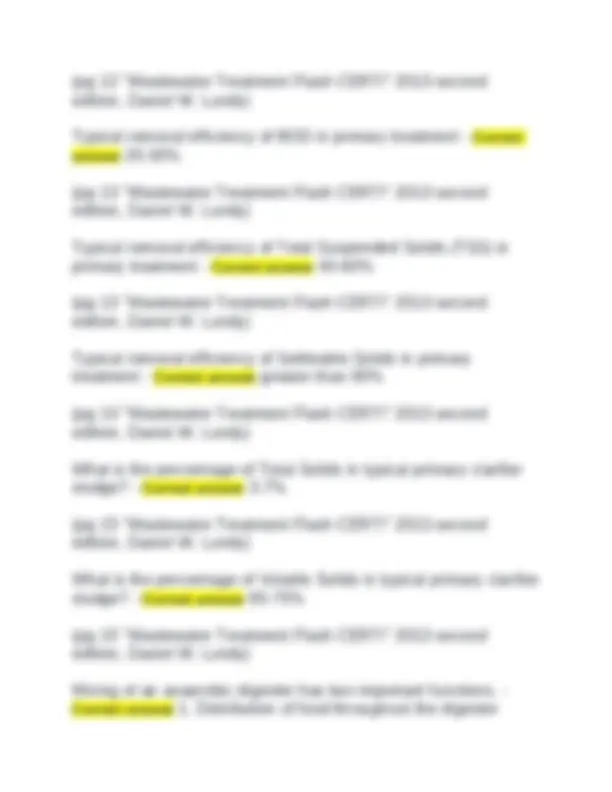
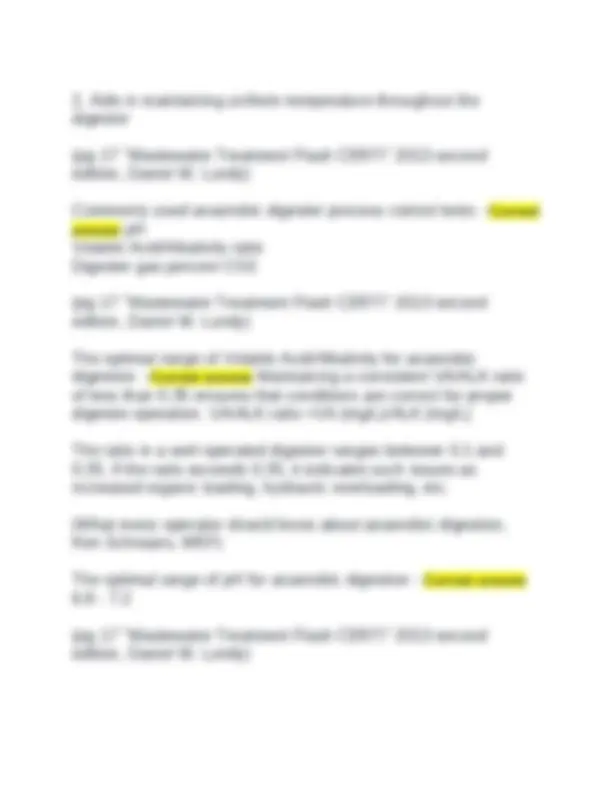
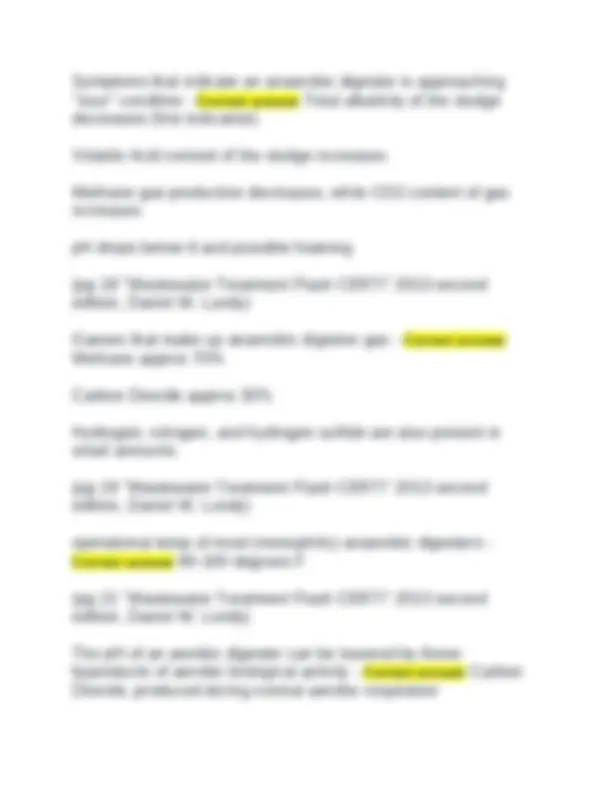
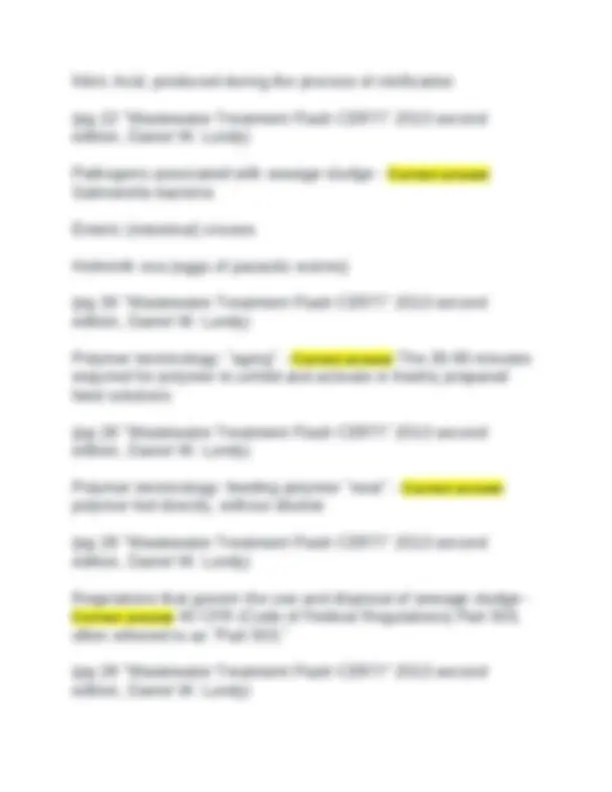
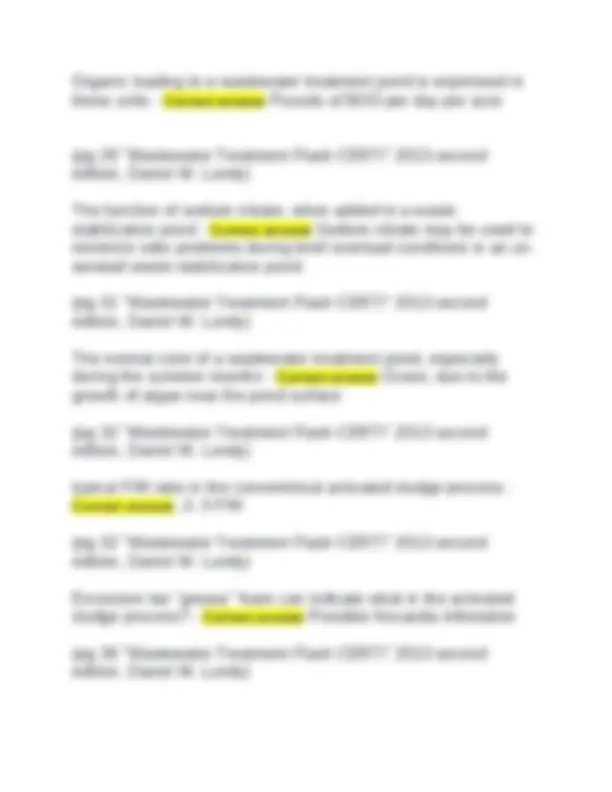
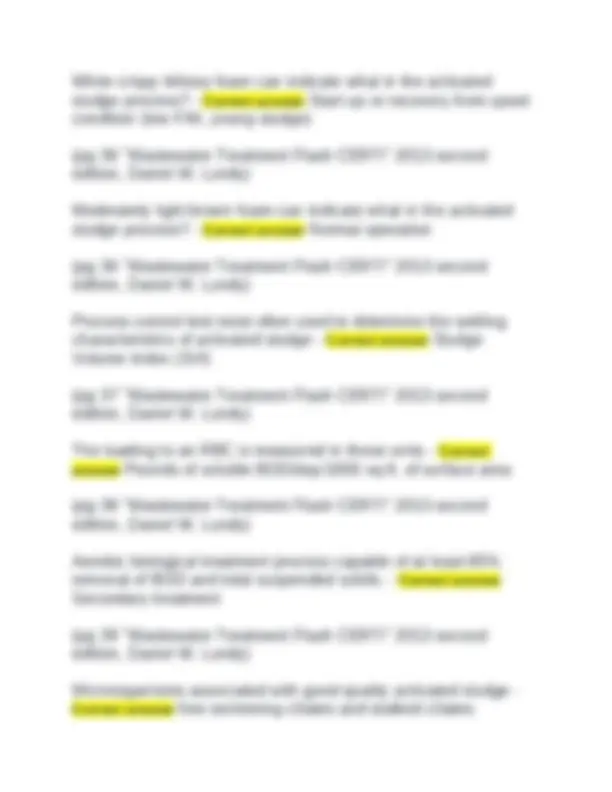
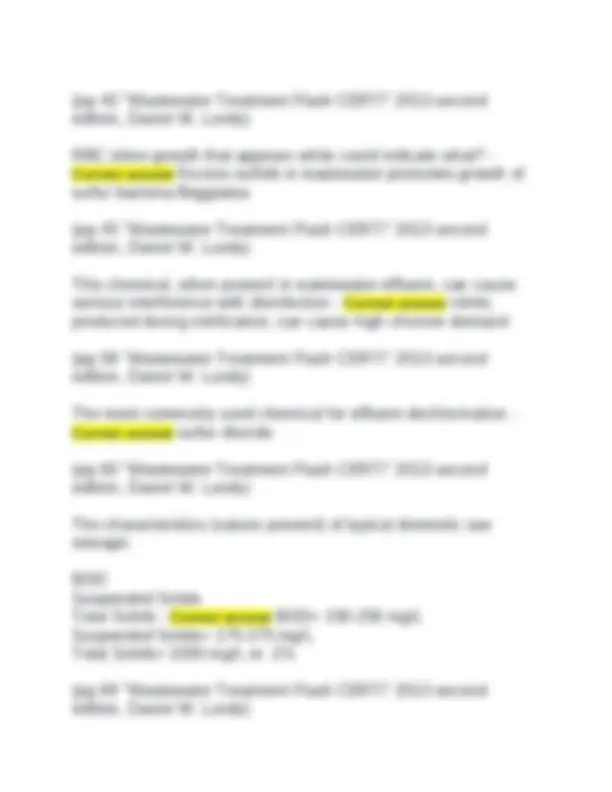
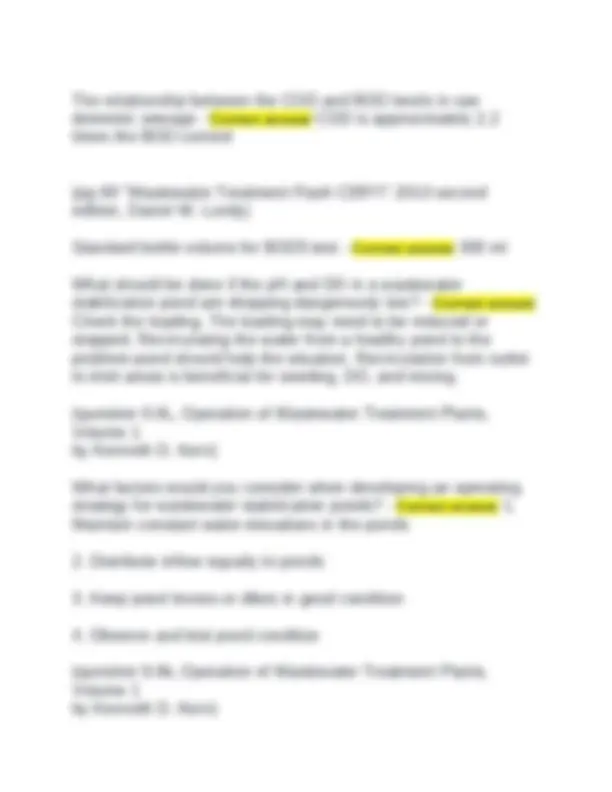
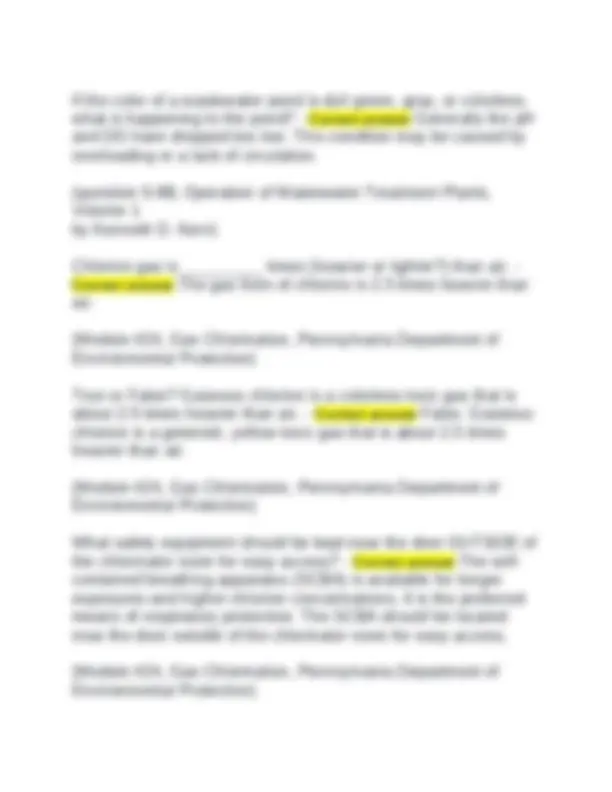
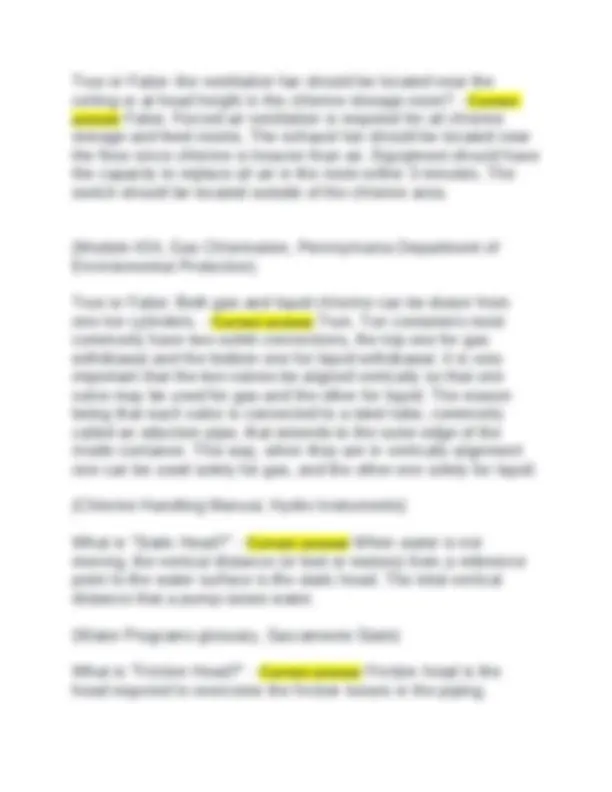
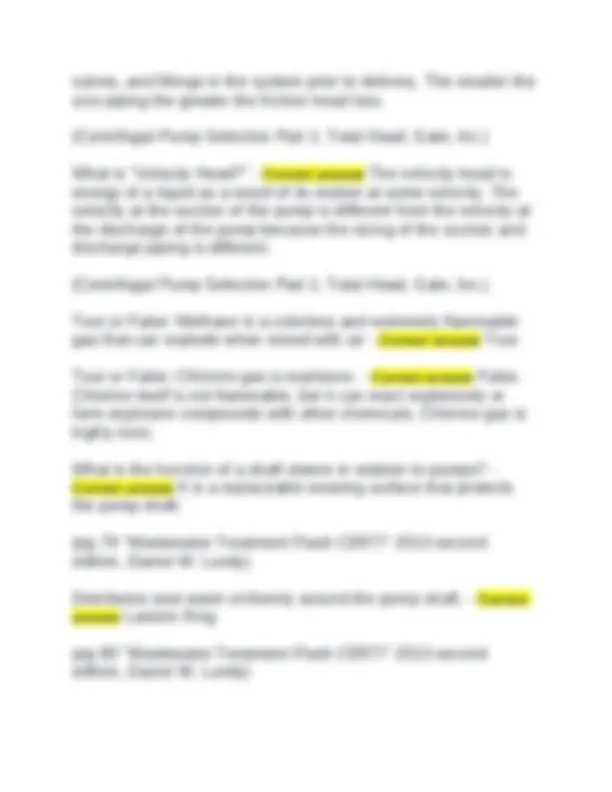
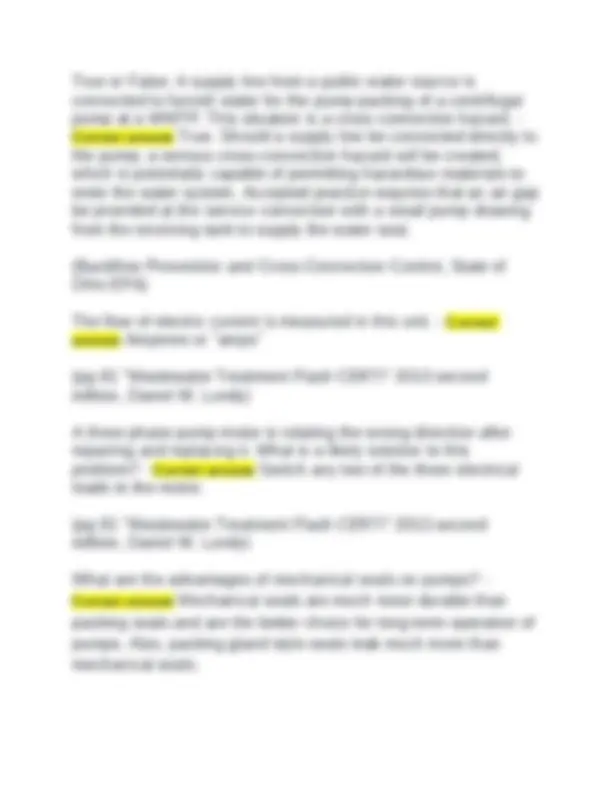


Study with the several resources on Docsity

Earn points by helping other students or get them with a premium plan


Prepare for your exams
Study with the several resources on Docsity

Earn points to download
Earn points by helping other students or get them with a premium plan
Community
Ask the community for help and clear up your study doubts
Discover the best universities in your country according to Docsity users
Free resources
Download our free guides on studying techniques, anxiety management strategies, and thesis advice from Docsity tutors
Operation of Wastewater Treatment Plants (Levels 1-2 Exam Prep) Questions and Answers.Operation of Wastewater Treatment Plants (Levels 1-2 Exam Prep) Questions and Answers.
Typology: Exams
1 / 33

This page cannot be seen from the preview
Don't miss anything!


























An Imhoff cone is used to measure________solids. A. suspended B. colloidal C. volatile D. settleable - Correct answer D. settleable (Operation of Wastewater Treatment Plants, Volume 1 by Kenneth D. Kerri) A _____ flume is widely used for measuring wastewater flow. - Correct answer Parshall (Operation of Wastewater Treatment Plants, Volume 1 by Kenneth D. Kerri) Velocity of flow in a grit channel must be reduced to a range of ____ to _____ fps in order for grit to properly settle. - Correct answer .7 to 1.4 fps (Operation of Wastewater Treatment Plants, Volume 1, 3. by Kenneth D. Kerri) With respect to grit removal systems, grit is traditionally defined as particles larger than 0.21mm (0.008 in) (65 mesh) and with a specific gravity of greater than ______. - Correct answer specific gravity of grit is 2.65 or greater (EPA Wastewater Technology Fact Sheet, Screening and Grit Removal)
Mechanically cleaned bar screens feature bars set at _____ to _____ degrees from vertical. - Correct answer Bars set at 0 to 30 degrees from vertical. (EPA Wastewater Technology Fact Sheet, Screening and Grit Removal) Manually cleaned bar screens feature bars set at _____ to _____ degrees from vertical to facilitate cleaning. - Correct answer Bars set at 30 to 45 degrees from vertical to facilitate cleaning. Primarily used in older or smaller treatment facilities, or in bypass channels. (EPA Wastewater Technology Fact Sheet, Screening and Grit Removal) The BOD test measures the amount of oxygen that is consumed while a sample of wastewater is incubated in the dark at a temperature of _____ °C for _____ days (± _____ hours) - Correct answer The BOD test measures the amount of oxygen that is consumed while a sample of wastewater is incubated in the dark at a temperature of 20 °C for 5 days (± 3 hours) (USGS Book 9-A7 (Third Edition) Five-Day Biochemical Oxygen Demand) What do we mean by Total Dissolved Solids (TDS) in wastewater? - Correct answer All the solids that cannot be filtered out of the water (New Mexico Wastewater Systems Operator Certification Study Manual)
Primary Clarifier Efficiencies: Settleable Solids expected removal efficiency 95% to 99% (New Mexico Wastewater Systems Operator Certification Study Manual) Typical Primary Clarifier Efficiencies: Suspended Solids expected removal efficiency _____% to _____% - Correct answer Typical Primary Clarifier Efficiencies: Suspended Solids expected removal efficiency 40% to 60% (New Mexico Wastewater Systems Operator Certification Study Manual) Typical Primary Clarifier Efficiencies: Total Solids expected removal efficiency _____% to _____% - Correct answer Typical Primary Clarifier Efficiencies: Total Solids expected removal efficiency 10% to 15% (New Mexico Wastewater Systems Operator Certification Study Manual) Typical Primary Clarifier Efficiencies: Biochemical Oxygen Demand (BOD) expected removal efficiency _____% to _____% - Correct answer Typical Primary Clarifier Efficiencies: Biochemical Oxygen Demand (BOD) expected removal efficiency 20% to 50% (New Mexico Wastewater Systems Operator Certification Study Manual) Sludge septicity in the primary clarifier can be recognized when: A. sludge gasification causes large clumps of sludge to float on the water surface.
B. Primary clarifier foam is black C. The Specific Oxygen Uptake Rate (SOUR) in the primary clarifier is greater than 3000 mg O2/L/hr D. The sludge contains from 4.0 to 8.0 percent dry solids in TS laboratory testing E. All of the above - Correct answer A. sludge gasification causes large clumps of sludge to float on the water surface. Pump cavitation may be caused by: A. Loss of discharge pressure due to open hy-drants or line breaks B. Closed suction valve C. Obstruction in the suction line D. Low suction head due to drop in water level E. All of the above - Correct answer E. All of the above (New Mexico Wastewater Systems Operator Certification Study Manual) A minimum dissolved oxygen (D.O.) level of _____ mg/L is recommended in the aeration tank for most basic types of activated sludge processes. - Correct answer A minimum dissolved oxygen (D.O.) level of 1.0 mg/L is recommended in the aeration tank for most basic types of activated sludge processes. Maintaining > 1.0 mg/L of D.O. contributes to establishing a
by Kenneth D. Kerri) Typical operating parameters for conventional activated sludge systems: MLSS in aeration basin = _____-_____ mg/L - Correct answer Typical operating parameters for conventional activated sludge systems: MLSS in aeration basin = 1000-4000 mg/L What is the main difference between sludge from primary and secondary clarifiers? - Correct answer The main difference between the sludge from primary and secondary clarifiers is that the primary sludge is usually denser than secondary sludge. (Operation of Wastewater Treatment Plants, Volume 1, question 5.0A by Kenneth D. Kerri) What are some causes of floating sludge (bulking) in a primary clarifier? - Correct answer • Sludge decomposing in tank, lifted by gasification
by Kenneth D. Kerri) What are some causes of black and odorous septic wastewater in primary clarifier effluent? - Correct answer • Improper sludge removal
by Kenneth D. Kerri) List the basic laboratory tests used to determine clarifier efficiency. - Correct answer The basic laboratory tests used to determine clarifier efficiency are DO, settleable solids, pH, temperature, BOD, suspended solids, chlorine residual (if needed), and coliform group bacteria (if needed). (Operation of Wastewater Treatment Plants, Volume 1, section 5.2A by Kenneth D. Kerri) Primary treatment is effective in removing (a) _____________, and (b) _______________, but is not nearly as effective in removing (c) __________________, which may exert a strong oxygen demand on the receiving waters. - Correct answer Primary treatment is effective in removing (a) settleable solids, and (b) scum or floatable solids, but is not nearly as effective in removing (c) lighter suspended solids or dissolved solids, which may exert a strong oxygen demand on the receiving waters. (Operation of Wastewater Treatment Plants, Volume 1, section 6.0A by Kenneth D. Kerri) The major consideration for daily operation of a trickling filter is to use the ______ recirculation rates that will produce good results (meet NPDES permit requirements), but not cause ponding and other problems. - Correct answer The major consideration for daily
by Kenneth D. Kerri) What is the RPM rate in which RBC units rotate? - Correct answer 1.5 RPM (Operation of Wastewater Treatment Plants, Volume 1, section
by Kenneth D. Kerri)
For rotating biological contactors, what is the approximate percentage of media surface immersed in wastewater while in operation? - Correct answer 40% (Operation of Wastewater Treatment Plants, Volume 1, section
by Kenneth D. Kerri) Why is the RBC process divided into four or more stages? - Correct answer The RBC process is divided into four or more stages to increase the effectiveness of a given amount of media surface area. Organisms on the first-stage media are exposed to high levels of BOD and reduce the BOD at a high rate. As the BOD levels decrease from stage to stage, the rate at which the organisms can remove BOD decreases and nitrification starts. (Operation of Wastewater Treatment Plants, Volume 1, section 7.0B by Kenneth D. Kerri) Nitrification in nature is a two-step oxidation process of ammonium (NH4+) or ammonia (NH3) to nitrate (NO3−) catalyzed by two ubiquitous bacterial groups. The first reaction is oxidation of ammonium to nitrite by ammonia oxidizing bacteria represented by the (a.)______ genus. The second reaction is oxidation of nitrite (NO2−) to nitrate by nitrite-oxidizing bacteria, represented by the (b.) ______ genus. - Correct answer (a.) Nitrosomonas, (b.) Nitrobacter _______ is an aerobic process in which bacteria change the ammonia and organic nitrogen in wastewater into oxidized nitrogen (usually nitrate). The second-stage BOD is sometimes referred to as the "nitrogenous BOD" (first-stage BOD is called the "carbonaceous BOD"). - Correct answer Nitrification is an
If the DO is too high in an aeration basin, ____________ may form and the secondary clarification process may not be able to remove the _________. - Correct answer If the DO is too high in an aeration basin, "pinpoint" floc may form and the secondary clarification process may not be able to remove the "pin" floc. (Operation of Wastewater Treatment Plants, Volume 1, section
by Kenneth D. Kerri) At what point of the day do wastewater stabilization ponds have the lowest pH? - Correct answer Late night & early morning. Diurnal variations of both pH and dissolved oxygen are found in wastewater treatment ponds. During the day, algae use carbon dioxide which raises the pH while at night they produce carbon dioxide and the pH is lowered. (Operation of Wastewater Treatment Plants, Volume 1, section
by Kenneth D. Kerri) How is oxygen produced by algae? - Correct answer Algae produce oxygen from the oxygen in the carbon dioxide molecule (CO2) through photosynthesis (Operation of Wastewater Treatment Plants, Volume 1, section 9.3A by Kenneth D. Kerri) True or False: A facultative treatment pond is seeded with specially selected algae to optimize the treatment process for the climate and conditions. - Correct answer False. Algae simply appear in a pond on their own without seeding. They are found in soil, water, and air and multiply under favorable conditions.
(Operation of Wastewater Treatment Plants, Volume 1, section 9.3B by Kenneth D. Kerri) What does a definite green color in a treatment pond indicate? - Correct answer A definite green color in a pond indicates a flourishing algal population and is a good sign. (Operation of Wastewater Treatment Plants, Volume 1, section 9.5C by Kenneth D. Kerri) When should a wastewater treatment pond be started? - Correct answer Ponds should be started during the warmer months because higher temperatures are associated with efficient treatment processes. (Operation of Wastewater Treatment Plants, Volume 1, section 9.5B by Kenneth D. Kerri) What should be done if the pH and DO in a pond are dropping dangerously low? - Correct answer Check the loading. The loading may need to be reduced or stopped. Recirculating the water from a healthy pond to the problem pond should help the situation. Recirculation from outlet to inlet areas is beneficial for seeding, DO, and mixing. (Operation of Wastewater Treatment Plants, Volume 1, section 9.6L by Kenneth D. Kerri) What is the maximum daily withdrawal rate of chlorine gas used for wastewater disinfection, from a one ton cylinder? - Correct answer 400 lbs. The maximum withdrawal rate of chlorine gas
A. Headworks basins B. Pre-aeration treatment units C. Preliminary treatment units D. Primary treatment units - Correct answer D. Primary treatment units (Operation of Wastewater Treatment Plants, Volume 1, comprehensive review questions # by Kenneth D. Kerri) When evaluating trickling filter operation records, operators should adjust the process according to which main principle?
by Kenneth D. Kerri) How can foaming be controlled in an aeration tank?
(Operation of Wastewater Treatment Plants, Volume 1, comprehensive review questions # by Kenneth D. Kerri) What is the typical removal efficiency of settleable solids in a primary clarifier? A. 10 to 15% B. 20 to 50% C. 40 to 60% D. 95 to 99% - Correct answer D. 95 to 99% (Operation of Wastewater Treatment Plants, Volume 1, section
by Kenneth D. Kerri) What is the maximum holding time of a sample before performing a BOD5 test (providing that the sample is kept at 4 degrees C and above freezing)? - Correct answer 48 hours maximum. The 48 hours starts when the very first aliquot of a composite sample is collected (i.e. when the composite sampler starts collecting a composite sample). (PA Dept. of Environmental Protection, BOD doc) Drying oven temp to determine Total Solids in sample - Correct answer 103-105 degrees C ("Wastewater Treatment Flash CERT!" 2013 second edition, Daniel W. Lundy) Drying oven temp to determine Total Dissolved Solids (TDS) in sample - Correct answer 180 +/- 2 degrees C
("Wastewater Treatment Flash CERT!" 2013 second edition, Daniel W. Lundy) Drying oven temp to determine Total Suspended Solids (TSS) in sample - Correct answer 103-105 degrees C ("Wastewater Treatment Flash CERT!" 2013 second edition, Daniel W. Lundy) Chemical used to dechlorinate samples for BOD testing - Correct answer Sodium Sulfite (pg 76 "Wastewater Treatment Flash CERT!" 2013 second edition, Daniel W. Lundy) At a WWTP, what can the following color codes on piping indicate? Brown Orange Green Blue Gray Yellow Purple - Correct answer Brown=Sludge Orange=Natural Gas/Digester Gas Green=Compressed air Blue=Water Gray=Wastewater Yellow=Chlorine Purple=Reuse (pg 83 "Wastewater Treatment Flash CERT!" 2013 second edition, Daniel W. Lundy)